Despite recent public outcry and opposition to the construction of a mosque in one of Tehran’s public parks, the head of the city council definitely said: "We should build prayer rooms and mosques in all parks."
Tehran’s citizens swiftly demanded the municipality stop the building of the mosque with a petition that circulated on social networks, garnering over 147,000 signatures within just a few days.
But, this all transcends the mere building of a mosque in Qaytariyeh Park in the north of Tehran.
Since 1979, the Islamist regime has escalated the count of mosques in Iran from approximately 25,000 to roughly 75,000 presently. Yet, as stated by a senior cleric within the regime, around 50,000 of these mosques remain shuttered, devoid of congregants for prayer.
Various polls converge on a singular explanation: the remarkable and rapid transformation of the Iranian populace towards irreligiosity and apathy towards religious rituals over the past four decades.
Last year, in a government study titled the National Attitude Survey of Iranians, respondents were asked about the change in the level of religiosity among the people compared to five years prior. 85% of respondents stated that, based on their observations, the level of religiosity among Iranians had decreased, while only 7% reported an increase.
So, why does the Islamist regime insist on building mosques that are likely to remain empty?
First: New mosques are constructed in areas where Basij bases and repression centers are absent or few, and the government uses the mosques as cover to expand its social and political control.
The Basij, which plays a significant role in quelling dissent, is a paramilitary volunteer militia force that operates under the Islamic Revolutionary Guards (IRGC).
In the past, the country's mosques have indeed been used to mobilize forces during street protests, and protesters have even been shot by Basiji snipers from rooftops. The government also seeks to establish a surveillance and information-gathering infrastructure within neighborhoods, without paying the price associated with public intimidation.
Second: The mosques are a base for gathering and recruiting for the regime's repression organizations. Today, the Islamist regime is desperately seeking to expand the network of Basiji forces and its plainclothes forces. In the past, these forces were the ones who assassinated the opposition figures. There were mosques with Imams such as Mojtaba Tehrani and Azizullah Khushvaght who were accused of issuing fatwas for killing dissidents and writers.
The attendees of their mosques were mostly working for the Iranian security agencies. The assassin who shot Saeed Hajjarian, an advisor to former President Mohammad Khatami, in the head, was affiliated with one of the politicized mosques.
Supreme Leader Ali Khamenei has filled his security, military, and paramilitary apparatus with worshipers of the same type of mosques.
Third: The state-controlled mosques have become centers of brainwashing and political propaganda. These mosques host kindergartens and indoctrination classes that propagate anti-Semitism, anti-Westernism, anti-Americanism, and political Islam.
All of the aforementioned objectives are centered around security and political agendas.
The objective of attaining complete state control over mosques in matters of religion and religiosity entails direct intervention by governmental institutions in the organization and execution of religious ceremonies. This is achieved through: the appropriation of public spaces by advocating Sharia as a way of life, and by substituting religious teachings with governmental directives.
Prior to the establishment of the Islamist regime in 1979, Iranian mosques served as civil institutions for worship and congregation, with ownership being shared. The Imam of the congregation was selected by the local community, and management was overseen by a board of trustees elected by the locals, with minimal political involvement. Every class and group of Muslims could claim the local mosque as their own.
However, the Islamist regime usurped the mosques by establishing Basij bases, appointing Imams, and constructing new and additional mosques. Following the usurpation, it treated the public domain as its conquered property.
Over the past 45 years, any Imam who has made a critical statement against the government has been dismissed from their position. Sunnis are unable to have even a single mosque in major cities like Tehran, Mashhad, Kerman, and Shiraz.
The country's mosques underwent governmentalization through three specific processes.
The first involved the formation of the Headquarters of Imams and Congregations to appoint and control mosque imams. This institution was established in every province and operates under the supervision of the Leader’s office.
The second process entailed the establishment of Basij bases in mosques as the initial government institution installed there.
The third process involved setting up "cultural centers" within mosques, managed by the Supreme Headquarters of the Cultural and Artistic Centers of the country's mosques, aimed at countering the "cultural invasion of the enemy" as mandated by the Supreme Council of the Cultural Revolution in 1992.
This way, the Islamist regime turned mosques that the Iranian people voluntarily built with their own hands and funds, into government institutions.
The regime transferred religious institutions such as seminaries, mosques, endowments, and mausoleums from civil institutions into completely state-owned entities.
